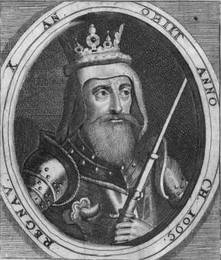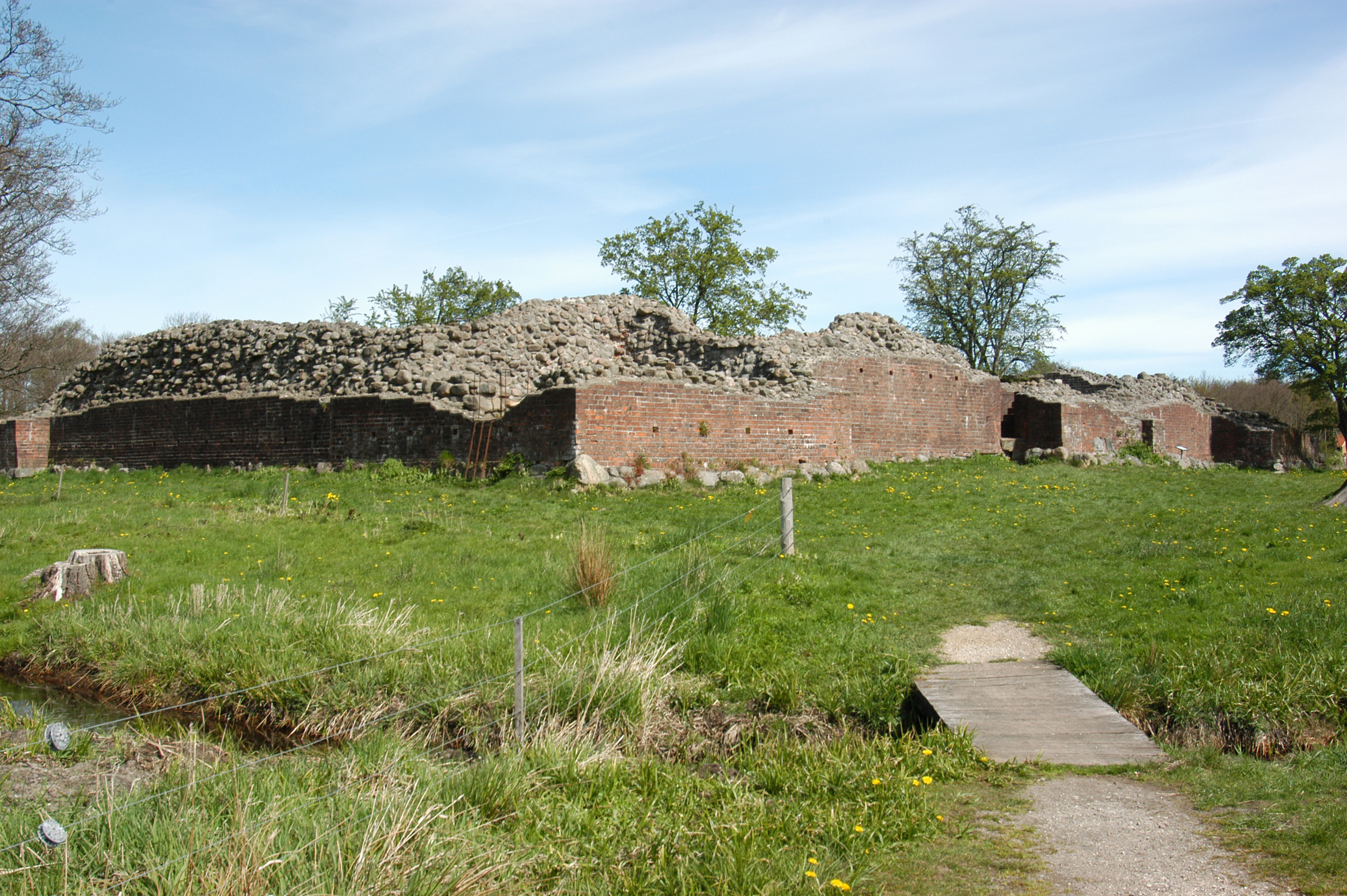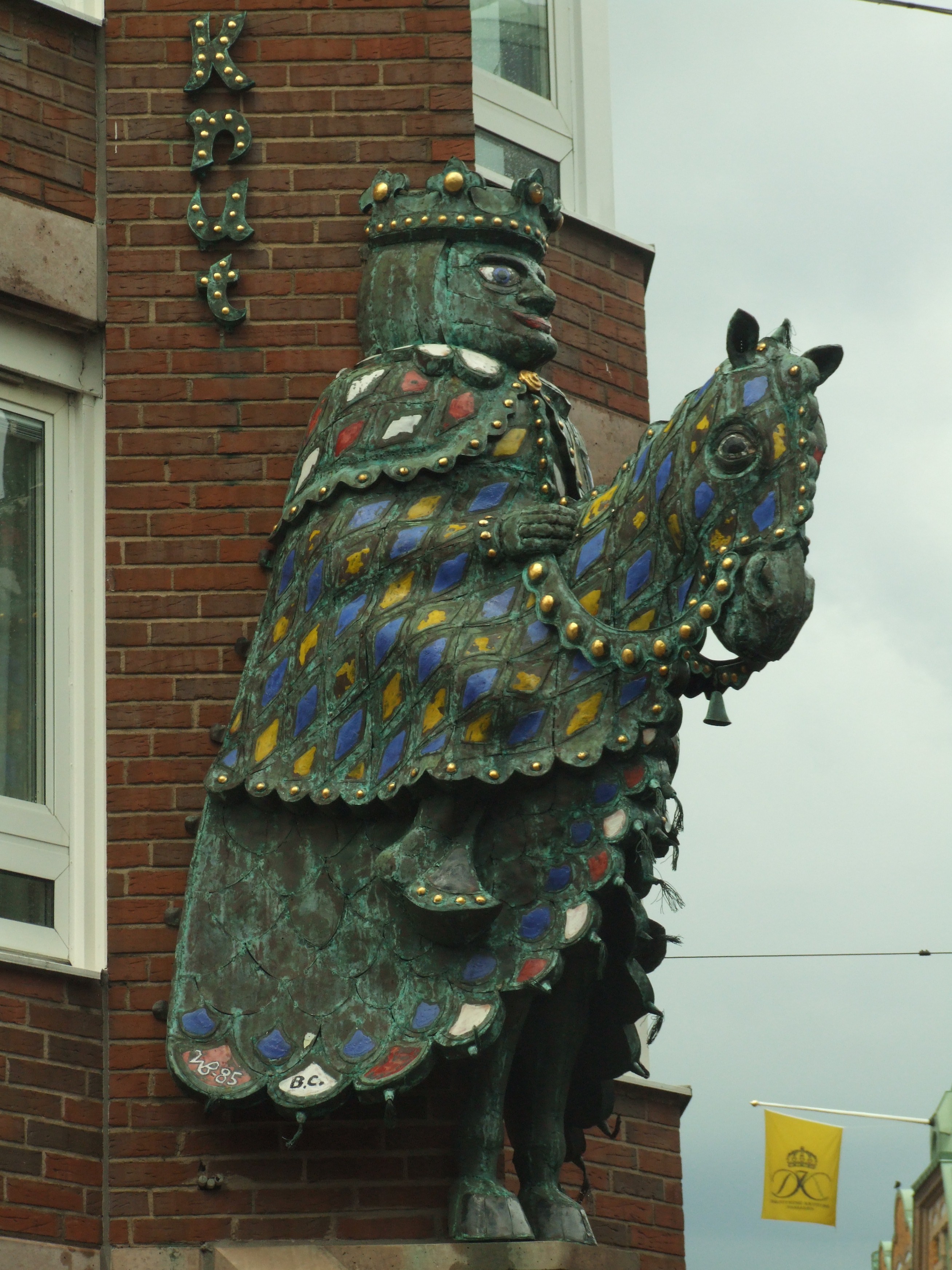|
Valdemar III
Valdemar III (1314–1364) was King of Denmark from 1326 to 1329, while he was underage; he was also Duke of Schleswig as Valdemar V in 1325–26 and from 1330 to 1364. He was a rival king set up against the unsuccessful Christopher II and was widely opposed by his subjects. His term was ended when he abdicated. Sometimes the earlier King Valdemar the Young (c. 1209–1231) is also referred to as Valdemar III. Biography Valdemar's father was Duke Eric II of Schleswig and his mother was Adelaide, daughter of Henry I of Rendsborg. When his distant kinsman and the head of the rival royal branch Christopher II of Denmark was exiled from his kingdom, Holsteiner and Danish high nobles got to choose a new king. Their choice fell to 11-year-old Duke Valdemar V of Schleswig, who was the head of the branch descended from King Abel of Denmark. Due to his young age, his maternal uncle, the mighty Count Gerhard of Rendsborg (Gerhard III of Holstein) who also was the biggest pawnbroker of ... [...More Info...] [...Related Items...] OR: [Wikipedia] [Google] [Baidu] |
King Of Denmark
The monarchy of Denmark is a constitutional political system, institution and a historic office of the Kingdom of Denmark. The Kingdom includes Denmark proper and the autonomous administrative division, autonomous territories of the Faroe Islands and Greenland. The Kingdom of Denmark was already consolidated in the 8th century, whose rulers are consistently referred to in Franks, Frankish sources (and in some late Frisians, Frisian sources) as "kings" (). Under the rule of King Gudfred in 804 the Kingdom may have included all the major provinces of medieval Denmark. The current unified Kingdom of Denmark was founded or re-united by the Vikings, Viking kings Gorm the Old and Harald Bluetooth in the 10th century. Originally an elective monarchy, it became hereditary monarchy, hereditary only in the 17th century during the reign of Frederick III of Denmark, Frederick III. A decisive transition to a constitutional monarchy occurred in 1849 with the writing of the first democrat ... [...More Info...] [...Related Items...] OR: [Wikipedia] [Google] [Baidu] |
Dukes Of Schleswig
The following is a list of jarls and dukes, who ruled over Schleswig respectively Southern Jutland (Sønderjylland). First jarls/dukes Houses of Estridsen and Schauenburg (1080–1460) House of Oldenburg In 1864, following the Second Schleswig War, the Duchy of Schleswig-Holstein became an occupied territory of the German Confederation and two years later, following the Austro-Prussian War, part of the new Prussian Province of Schleswig-Holstein. See also *List of Danish monarchs *List of rulers of Schleswig-Holstein The following is a list of rulers (usually dukes) who ruled both Schleswig and Holstein, starting from the first Holstein count who received Schleswig, until both territories were annexed by the Kingdom of Prussia in 1866; and afterwards, titular ... Notes {{DEFAULTSORT:Schleswig, Dukes Of Lists of Danish people Lists of monarchs Dukedoms of Germany People from the Duchy of Schleswig * Lists of dukes ... [...More Info...] [...Related Items...] OR: [Wikipedia] [Google] [Baidu] |
Valdemar IV Of Denmark
Valdemar IV Atterdag (the epithet meaning "Return of the Day"), or Waldemar (132024 October 1375) was King of Denmark from 1340 to 1375. He is mostly known for his reunion of Denmark after the bankruptcy and mortgaging of the country to finance wars under previous rulers. Accession He was the youngest son of King Christopher II of Denmark and Euphemia of Pomerania. He spent most of his childhood and youth in exile at the court of Emperor Louis IV in Bavaria, after the defeats of his father and the death and imprisonment, respectively, of his two older brothers, Eric and Otto, at the hand of the Holsteiners. Here he acted as a pretender, waiting for a comeback. Following the assassination of Gerhard III, Count of Holstein-Rendsburg, by Niels Ebbesen and his brothers, Valdemar was proclaimed king of Denmark at the Viborg Assembly (''landsting'') on St John's Day (St Hans' Day) on 24 June 1340, led by Ebbesen. By his marriage with Helvig of Schleswig, the daughter of Eric II, Du ... [...More Info...] [...Related Items...] OR: [Wikipedia] [Google] [Baidu] |
Otto, Duke Of Lolland And Estonia
Otto of Denmark (c. 1310 – after 1346) ( da, Otto Christoffersen) was a Danish prince who was also Duke of Lolland and Estonia. He was the second son of King Christopher II of Denmark and Euphemia of Pomerania. In his childhood his older brother Eric had been elected as junior king of Denmark. Otto was given the titles Duke of Lolland and Estonia and was expected to expand the Danish conquest of Estonia acquired during Livonian Crusade. His father and brother were deposed in 1326 and restored three years later on the condition his father signed a charter that gave him little to no power while the Danish nobles and the counts of Holstein ruled behind the scene and mortgaged most of the kingdom. His brother Eric predeceased both Otto and his father, fighting to rid Denmark from the rule of the counts of Holstein. King Christopher died in 1332, leaving Otto and his younger brother Valdemar as his only sons and potential heirs to the throne. The Danish nobles for some reason deci ... [...More Info...] [...Related Items...] OR: [Wikipedia] [Google] [Baidu] |
Ingeborg Of Norway
Ingeborg of Norway (Old Norse ''Ingibjörg Hákonardóttir'', Swedish ''Ingeborg Håkansdotter'', Norwegian ''Ingebjørg Håkonsdatter''; 1301 – 17 June 1361), was a Norwegian princess and by marriage a Swedish royal duchess with a position in the regency governments in Norway (1319–27) and Sweden (1319–26) during the minority of her son, King Magnus of Norway and Sweden. In 1318–1319, she was Sweden's ''de facto'' ruler, and from 1319 until 1326, she was Sweden's first ''de jure'' female regent. Her role in northern European history is considered of major importance. Life Early life Ingeborg was born in 1301 as the only legitimate daughter of King Håkon V of Norway from his marriage with Euphemia of Rügen. As a child, she was first betrothed to Magnus Birgerson, the son and designated heir of Birger, King of Sweden. Soon afterwards the engagement was however broken for altered political reasons, and in 1305 she was betrothed to Eric, Duke of Södermanland, a younger ... [...More Info...] [...Related Items...] OR: [Wikipedia] [Google] [Baidu] |
Knud Porse
Canute Porse the Elder or ''Knud/Knut Porse'' (died 30 May 1330) was a medieval Danish nobleman and Duke of Samsø, Duke of Halland, and Duke of Estonia. Biography Porse was the son of Peder Porse, who was one of several Danish nobleman involved in the assassination of King Eric V of Denmark and thus was exiled since 1286 with his family. On 21 June 1327, Porse married Norwegian princess Ingeborg (1301–1361), daughter of King Haakon V of Norway (1270–1319). She was also Duchess of Södermanland by her first marriage to Swedish prince Eric Magnusson, Duke of Södermanland (1282–1318). Through her first marriage, she was the mother of King Magnus (IV & VII) of Sweden and Norway (1316–1374) and of Euphemia of Sweden (1317–1370) wife of Albert II, Duke of Mecklenburg. Before marrying Duchess Ingeborg, Porse had led the troops that put a military end to the reign of her brother-in-law King Birger in 1318. In 1322, without the approval of the Swedish government, h ... [...More Info...] [...Related Items...] OR: [Wikipedia] [Google] [Baidu] |
List Of Rulers Of Estonia
This list of rulers of Estonia starts with the ancient counties (''maakond'') and parishes (''kihelkond'') each headed by ''Seniores'' and ''Meliores'' (Elders) as noted by Henry of Livonia. The administrative jurisdiction of the parish and county elders was limited, the counties themselves remained autonomous until the Teutonic and Danish conquest of Estonia in the 13th century. Ending with the states and the rulers of states (starting from the time of the first successful Danish conquest in 1219) who either ruled or laid claims of sovereignty over some parts of the territory of present-day Estonia, as well as the leaders of the independent Republic of Estonia since 1918. Ancient counties Alempois Title: Elder (-1224) Harju Title: Elder (-1224) Järva Title: Elder (-1224) Jogentagana Title: Elder (-1224) Läänemaa Title: Elder (-1224) Mõhu Title: Elder (-1224) Nurmekund Title: Elder (-1224) Revala Title: Elder (-1224) Saaremaa Title: Elder – It is probable t ... [...More Info...] [...Related Items...] OR: [Wikipedia] [Google] [Baidu] |
List Of Danish Monarchs
This is a list of Danish monarchs, that is, the kings and queens regnant of Denmark. This includes: * The Kingdom of Denmark (up to 1397) ** Personal union of Denmark and Norway (1380–1397) * The Kalmar Union (1397–1536) ** Union of Denmark, Norway and Sweden (1397–1523) ** Union of Denmark and Norway (1523–1536/1537) * The United Kingdoms of Denmark–Norway (1536/1537–1814) * The Kingdom of Denmark (1814–present) ** Iceland (since the union between Denmark and Norway in 1380; independent kingdom in a personal union with Denmark 1918–1944; a sovereign republic since 1944) ** Greenland (since the union between Denmark and Norway in 1380; effective Danish–Norwegian control began in 1721; integrated into the Danish realm in 1953; internal home rule introduced 1979; self-determination assumed in 2009; Greenland has two out of 179 seats in the Danish parliament Folketinget) ** Faroe Islands (since the union between Denmark and Norway in 1380; County of Denmark 1816– ... [...More Info...] [...Related Items...] OR: [Wikipedia] [Google] [Baidu] |
Gunzelin VI, Count Of Schwerin
Gunzelin VI of Schwerin (died: 1327) was a son of Count Niklot I of Schwerin and his wife, Elisabeth of Holstein. In 1323, he succeeded his father in Schwerin-Wittenburg. He was married to Richardis of Tecklenburg, daughter of Count Otto IV of Tecklenburg. They had five children: * Otto (d. 1357) * Nicholas (d. 1367) * Matilda, married Count Henning of Gützkow * Beata, in 1334 married Albert IV, Duke of Saxe-Lauenburg * Richardis Saint Richardis ( la, Richgardis, Richardis), also known as Richgard, Richardis of Swabia and Richarde de Souabe in French ( 840 – 18 September, between 894 and 896 AD), was the Holy Roman Empress as the wife of Charles the Fat. She was re ... (d. 1384), married Valdemar V, Duke of Schleswig 1327 deaths 14th-century German nobility Counts of Schwerin Year of birth unknown {{Germany-noble-stub ... [...More Info...] [...Related Items...] OR: [Wikipedia] [Google] [Baidu] |
Valdemar IV
Valdemar IV Atterdag (the epithet meaning "Return of the Day"), or Waldemar (132024 October 1375) was King of Denmark from 1340 to 1375. He is mostly known for his reunion of Denmark after the bankruptcy and mortgaging of the country to finance wars under previous rulers. Accession He was the youngest son of King Christopher II of Denmark and Euphemia of Pomerania. He spent most of his childhood and youth in exile at the court of Emperor Louis IV in Bavaria, after the defeats of his father and the death and imprisonment, respectively, of his two older brothers, Eric and Otto, at the hand of the Holsteiners. Here he acted as a pretender, waiting for a comeback. Following the assassination of Gerhard III, Count of Holstein-Rendsburg, by Niels Ebbesen and his brothers, Valdemar was proclaimed king of Denmark at the Viborg Assembly (''landsting'') on St John's Day (St Hans' Day) on 24 June 1340, led by Ebbesen. By his marriage with Helvig of Schleswig, the daughter of Eric II, D ... [...More Info...] [...Related Items...] OR: [Wikipedia] [Google] [Baidu] |
Jutland
Jutland ( da, Jylland ; german: Jütland ; ang, Ēota land ), known anciently as the Cimbric or Cimbrian Peninsula ( la, Cimbricus Chersonesus; da, den Kimbriske Halvø, links=no or ; german: Kimbrische Halbinsel, links=no), is a peninsula of Northern Europe that forms the continental portion of Denmark and part of northern Germany. The names are derived from the Jutes and the Cimbri, respectively. As with the rest of Denmark, Jutland's terrain is flat, with a slightly elevated ridge down the central parts and relatively hilly terrains in the east. West Jutland is characterised by open lands, heaths, plains, and peat bogs, while East Jutland is more fertile with lakes and lush forests. Southwest Jutland is characterised by the Wadden Sea, a large unique international coastal region stretching through Denmark, Germany, and the Netherlands. Geography Jutland is a peninsula bounded by the North Sea to the west, the Skagerrak to the north, the Kattegat and Baltic Sea to the ... [...More Info...] [...Related Items...] OR: [Wikipedia] [Google] [Baidu] |






